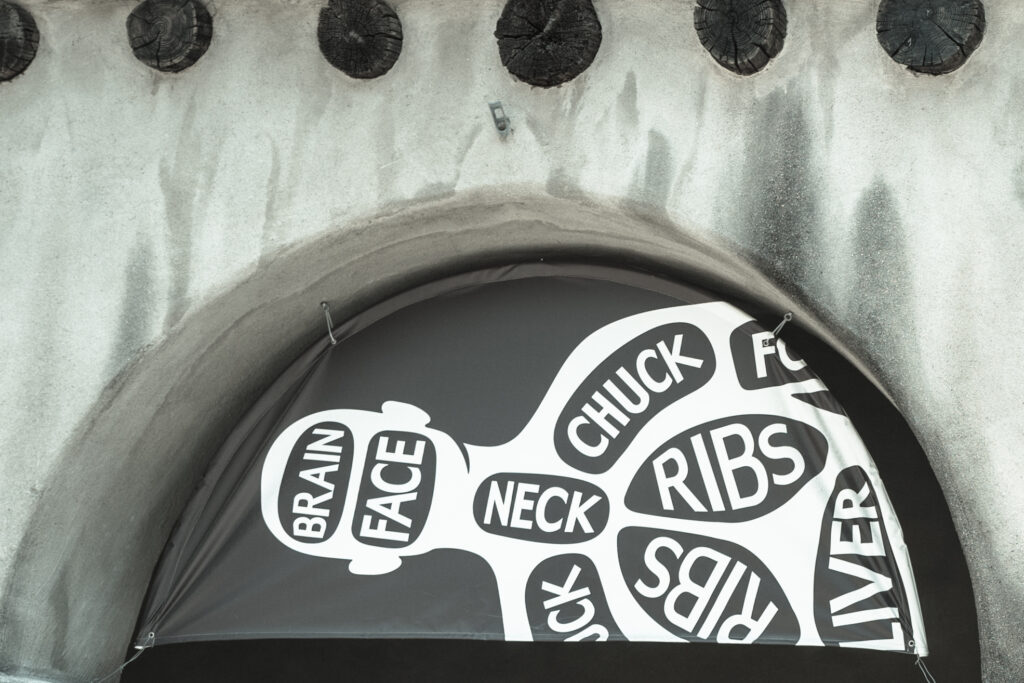I really want to know. That sentence, the title, and a short list of TV Shows about viral epidemics is as far as this post proceeded when I started it on April 26, 2016. I meant to come back many times over the nearly five years since and really regret the failure following the World Health Organization’s declaration of SARS-CoV-2 (severe acute respiratory syndrome Coronavirus 2)/COVID-19 as a pandemic on March 11, 2020.
Still contemplating writing this essay, but not getting to it, I shot and edited the Featured Image on June 11, 2017. San Diego’s Museum of Man (since then renamed to “Us”) featured exhibit “Cannibals: Myth & Reality”. With so many of the virus movies or TV series focused on Zombie apocalypses, the exhibit artwork seemed so perfect illustration. Vitals, aperture manually set: f/5.6, ISO 100, 1/1000 sec, 28mm; 2:07 p.m. PDT, Leica Q.
Half a decade later, I wonder: How much did pandemic feature films and TV shows create soil for COVID-19 to grow into a state of global fear—and, as I will opine in six days, far exceeds the real risk posed to the majority of people; whether or not they are infected? Surely, you can guess my answer.
Infection
Let’s start with my virus television series list put together five years ago:
- Containment (one season, 2016)
- Fear the Walking Dead (started 2015, six seasons and counting)
- The Last Ship (five seasons, 2014-18)
- The Strain (four seasons, 2014-17)
- The Walking Dead (started 2010, ending with season 11 next year)
- 12 Monkeys (four seasons, 2015-18)
- Z Nation (five seasons, 2014-18)
The shortlist excluded viral romps like Between and Helix, which ended their run in 2014 or 2015. Some series airing since 2016:
- Black Summer (one season so far, 2019)
- Condor (two seasons so far, 2018)
- The Hot Zone (one season, 2019)
- The Rain (three seasons so far, 2018-20)
- The Stand (limited series, 2020-21)
Then there are the movies and their impact on the global psyche for many decades. Under “Category:Films about viral outbreaks“, Wikipedia lists 131 movies. Among them:
- I Am Legend (2007)
- 28 Days Later (2002)
- Cargo (2017)
- Carriers (2009)
- Contagion (2011)
- Containment (2015)
- Flu (2013)
- Outbreak (1995)
- Patient Zero (2019)
- World War Z (2013)
All the television programs listed above can be streamed from the likes of Hulu or Netflix—and possibly the majority of the movies (I didn’t look to confirm). Meaning: Influence continues long after the film release or series run.
Disease
Viral armageddon storytelling is pretty consistent, thematically: People are infected and die or are transformed into something nonhuman but deadly; during the onset, scenes are often established by first responders and doctors dressed in HAZMAT suits with body bags—if not dead people—being everywhere; survivors fight for their lives; everyone avoids, or runs from, anyone else; constant fear is the emotional state conveyed to viewers (e.g. you); and the majority of films and series fall squarely into the horror category.
See where this is going?
A day, perhaps two, after China quarantined Wuhan in late January 2020, I warned my wife and repeated often thereafter: “Fear is the contagion”. I was lots less worried about the Novel Coronavirus than the reaction to it. Consider how Hollywood primed the pumps for fear to flow across the global human psyche. We have been programmed, so to speak, through our entertainment to react emotionally rather than rationally about pronounced pandemics. The fear is visceral, and maybe even subconscious.
But what is the real severity? The answer will be my topic for the one-year anniversary of the pandemic declaration on March 11. But consider what’s missing from Hollywood’s depiction vs reality: Hospitals aren’t overrun everywhere; people aren’t obviously sick and dying in the streets; body bags aren’t stacked up on sidewalks; government isn’t forcibly quarantining areas and sending in troops to enforce the restrictions; there is no martial law; people aren’t starving in their homes or on the streets; lawlessness hasn’t overtaken communities anywhere; and so on.
All the while, the news media tells us how dangerous is the pandemic. How about we look, rather than listen, and judge by what we don’t see.
COVID-19 does not in any real manner meet expectations that most of us might have about a pandemic. But the fear is there, and it’s the deadly infection. Perhaps, unintentionally, the entertainment industry is patient zero.
